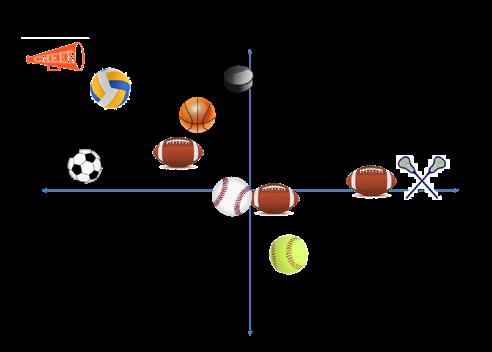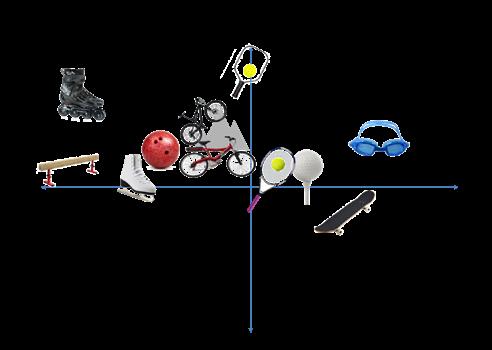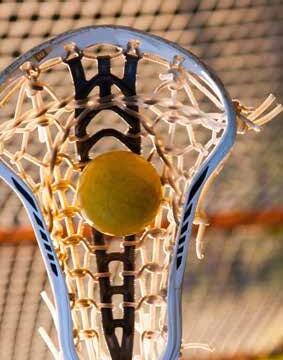
6 minute read
CHANGES and DRIVERS for TEAM, INDIVIDUAL and WHEEL SPORTS PARTICIPATION WHEEL
from NSGA NOW - July/August 2023
by NSGA
BY NICK RIGITANO NSGA DIRECTOR OF INSIGHTS AND ANALYSIS IN 2022
The 2023 edition of NSGA’s Sports Participation in the US report revealed increases for many of the sports within the team, individual and wheel sports segments, which are key areas for many sporting goods retailers, dealers and manufacturers.

Based on NSGA’s Total Participation Points (TPP) measure, the team segment experienced a slight increase in 2022 (+1.2%) compared to the prior year while the individual and wheel segments enjoyed larger increases of 7.2 percent and 4.2 percent respectively. TPPs offer a more complete view of participation because both the number of people participating in each sport segment (reach) and the number of sports each person is participating in (depth) are taken into account.
The perceptual map in Figure 1 illustrates the changes and drivers behind the segment increases. The y-axis indicates the overall percentage increase/decrease in youth team sports (ages 7-17) while the x-axis indicates the degree to which the increase/ decrease was driven by youth male or female participation.
To put things in perspective, ice hockey saw a 22% increase in youth participation and the changes in male vs. female participation were nearly split down the middle which is why the hockey puck icon is toward the top of the map but located very close to the y-axis. Softball, however, is located in the bottom right quadrant as the sport experienced a 10% decrease in youth participation, which was due to a decrease in male participation. This shouldn’t be too concerning to softball retailers, team dealers and manufacturers, however, as female participation, which accounted for more than 80 percent of youth softball participation in 2022, remained flat.

Besides ice hockey, two team sports experiencing the highest increases among youth in 2022 were cheerleading (+29%) and volleyball (+17%), which were driven by increases in female participation. The increases were welcome sights for both sports as youth volleyball surged back to pre-COVID levels while cheerleading fell just short of its pre-COVID mark. Increased participation among females also drove the gains seen by basketball, flag football and soccer. Males, on the other hand, drove the slight increases in youth tackle football and lacrosse. Baseball and touch football remained relatively flat among youth, only decreasing by 0.5 percent and 0.3 percent respectively.

Figure 2 illustrates the overall changes seen within the individual and wheel sports segments by gender. For the seventh consecutive year, pickleball (+79%) led these two segments in growth after the sport nearly doubled its participation compared to the previous year. Gains were split evenly between males and females. Strong years for female participation drove the increases for six of the remaining sports, led by in-line roller blading (+13%), which experienced its first increase in overall participation since 2020.
Gains in female participation outpaced the gains by males for mountain biking (off road), bicycle riding and bowling, while increases among females helped offset decreases in male participation for gymnastics and ice/figure skating. On the opposite side of the map, male participation increases outpaced the female increases seen in swimming (+6%), golf (+4%), and tennis (+3%). Skateboarding (-3%) was the only activity among these segments to experience a decrease in participation during 2022.
It was a solid year for the majority of team, individual and wheel sports in 2022. The challenge now will be to keep encouraging participation in these segments to build on this momentum and sustain growth. Using demographic data and tools such as perceptual maps can help us identify areas to target across the sports landscape. For more information on the report please visit www.nsga.org/research.

UNIFORM, APPAREL CHANGES IN HIGH SCHOOL BASKETBALL
High school basketball player uniforms and apparel for boys and girls were among two rules changes approved by the National Federation of State High School Associations (NFHS) for the 2023–24 season.
Rule 3-4-5 clarifies that multiple styles of uniform bottoms may be worn by teammates, but they must all be like-colored and adhere to uniform rules outlined in Rule 3-6-2 regarding logos and trademarks.
“Multiple styles” is referencing the option for players to wear skirts, pants, shorts, etc., and allows for religious or even personal accommodations without having to request permission, accord ing to Lindsey Atkinson, NFHS Director of Sports and liaison to the Basketball Rules Committee. Rule 3-6-2 requires all logos/trademarks must be limited to 2-1/4 square inches and shall not exceed 2-1/4 inches in any dimension on any item.
Rule 3-5-6 addresses undershirts and allows teams to wear a single solid color or solid black for visiting teams with dark jerseys. This provides an opportunity for schools with hard-to-find colors to have all players wear a black undershirt. The biggest on-court change next year will have teams shoot two free throws for common fouls when in the “bonus.” This change to Rule 4-8-1 eliminates the one-and-one scenario and sets new foul limits each quarter for awarding the bonus free throw.
In addition to awarding two free throws for all common fouls, teams will reach the bonus when their opponent commits five fouls in each quarter and team fouls will reset at the end of each quarter.
Previously, teams were awarded the one-and-one bonus when their opponents committed seven fouls in a half and two free throws when 10 fouls were committed each half.
Usa Lacrosse Issues
an existing legal women’s head such that the task group can determine there are no innovations in the geometry of the head: the file should be inclusive of the bottom rail angle from sweet spot to scoop tip, inclusive of the plastic lines and the shooting string hole placement as well as documentation both from the side and above to show all dimensions of the head.
Please note the following: process to review potential new women’s lacrosse stick heads for approval. The objective of the interim process is to work directly with equipment manufacturers to review products in a collaborative, professional and timely manner and to avoid disruption to manufacturers and consumers.
Protrusions on the front sidewall are prohibited. Any other unprecedented protrusions and/or sharp points will require a physical prototype of the head for review by the task force.
The task force reserves the right to review with the lab any notches on the sidewall that are potentially used to circumvent the intent of the current specifications.
The ultimate objective of USA Lacrosse, along with equipment manufacturers, technology and scientific subject matter experts, aims to develop an ASTM performance standard for women’s lacrosse sticks. USA Lacrosse’s goal is to have a draft standard for review at the November 2023 ASTM meeting. USA Lacrosse has put together a task force to assist in the interim review process.
Manufacturers shall submit to USA Lacrosse staff a passing lab report, along with:

An Engineering Drawing file that shows the proposed model as an overlay of
All materials will be shared with the task group and a unanimous vote will be required for sticks to be certified and legal for play. No less than two (2) weeks should be allowed for review upon submission. If additional data or supporting documentation is needed, a member of the task group will notify the industry contact. USA Lacrosse understands the information received is proprietary by nature and therefore acknowledges all materials submitted are for internal review only and are confidential.
The NCAA proposed two women’s lacrosse rule changes for 2023–24 impacting protective gear and footwear. One clarifies that lacrosse-specific ND200 close-fitting padded compression shirts can be worn underneath players’ jerseys to protect against commotio cordis. In the other, shoes could have soles containing aluminum, leather, rubber, nylon or plastic cleats, studs or bars, whether molded as part of the sole or detachable, if the official does not consider them dangerous. The proposals will be voted on July 19.
Continued on page 48
Continued from page 47
Ncaa Approves Basketball Uniform Number Change
Changes to basketball jerseys, including expanded use of numbers, were approved for NCAA men’s and women’s basketball with the start of the 2023–24 season. Additional uniform options, including identifying names of the institution, more space will be allowed for logos on the jersey front and numbers 0 or 00 through 99 will be permitted in NCAA men’s and women’s basketball. Religious headwear can be worn by players without a waiver of the playing rule provided it is safe for competition. Amber lights on the shot clock and/ or an amber strip at the top of the backboard only to signal the end of a shot-clock period will be permitted but not required. This will address games played in facilities with this equipment and provide another visual tool for officials to recognize when a shot-clock violation has occurred.
High School Wrestling Rules Changes
An alteration to the wrestler’s uniform and appearance and the trim allowable on the shoes of officials were among the revisions approved by the NFHS Board of Directors for the 2023–24 season.
In Rule 4 regarding the wrestler’s uniform and appearance, language was altered in Rule 4-1-1a to denote that the one-piece singlet may be worn with full-length, form-fitted tights. The stirrups requirement was deleted because the tights worn by wrestlers today do not ride up the wrestler’s leg causing a disadvantage to the opponent. A revision to Rule 3-1-1 will permit white or gray trim on the referee’s shoes.








